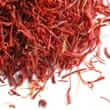Background
- Saffron is the dried stigma of the crocus (Crocus sativus) flower. It is available both as filaments and powder. Around 75,000 blossoms are needed to make a single pound of saffron. For this reason, the price of saffron can range from $50 to $300 per ounce.
- Saffron has a long history of use as a spice, medicine, and yellow dye. The crocus was reportedly used by ancient Greek and Roman civilizations and in medieval Egypt.
- Saffron may have anticancer, antidepressant, nerve protective, and antioxidant properties and may have effects on the immune system. Saffron has also been studied for its ability to improve symptoms of Alzheimer's disease, asthma, infertility, menstrual problems, and psoriasis.
References
- Agha-Hosseini M, Kashani L, Aleyaseen A, et al. Crocus sativus L. (saffron) in the treatment of premenstrual syndrome: a double-blind, randomised and placebo-controlled trial. BJOG 2008;115(4):515-9.
View Abstract - Akhondzadeh S, Shafiee Sabet M, Harirchian MH, et al. A 22-week, multicenter, randomized, double-blind controlled trial of Crocus sativus in the treatment of mild-to-moderate Alzheimer's disease. Psychopharmacology (Berl) 2010;207(4):637-43.
View Abstract - Aytekin A, Acikgoz AO. Hormone and microorganism treatments in the cultivation of saffron (Crocus sativus L.) plants. Molecules 2008;13(5):1135-47.
View Abstract - Carmona M, Zalacain A, Salinas MR, et al. A new approach to saffron aroma. Crit Rev Food Sci Nutr 2007;47(2):145-59.
View Abstract - Chryssanthi DG, Lamari FN, Iatrou G, et al. Inhibition of breast cancer cell proliferation by style constituents of different Crocus species. Anticancer Res 2007;27(1A):357-62.
View Abstract - Hosseinzadeh H, Ghenaati J. Evaluation of the antitussive effect of stigma and petals of saffron (Crocus sativus) and its components, safranal and crocin in guinea pigs. Fitoterapia 2006;77(6):446-8.
View Abstract - Kanakis CD, Tarantilis PA, Tajmir-Riahi HA, et al. Crocetin, dimethylcrocetin, and safranal bind human serum albumin: stability and antioxidative properties. J Agric Food Chem 2007;55(3):970-7.
View Abstract - Lechtenberg M, Schepmann D, Niehues M, et al. Quality and functionality of saffron: quality control, species assortment and affinity of extract and isolated saffron compounds to NMDA and sigma1 (sigma-1) receptors. Planta Med 2008;74(7):764-72.
View Abstract - Modaghegh MH, Shahabian M, Esmaeili HA, et al. Safety evaluation of saffron (Crocus sativus) tablets in healthy volunteers. Phytomedicine 2008;15(12):1032-7.
View Abstract - Nahid, K., Fariborz, M., Ataolah, G., and Solokian, S. The effect of an Iranian herbal drug on primary dysmenorrhea: a clinical controlled trial. J Midwifery Womens Health 2009;54(5):401-404.
View Abstract - Ordoudi SA, Befani CD, Nenadis N, et al. Further examination of antiradical properties of Crocus sativus stigmas extract rich in crocins. J Agric Food Chem 2009;57(8):3080-6.
View Abstract - Sadeghnia HR, Cortez MA, Liu D, et al. Antiabsence effects of safranal in acute experimental seizure models: EEG and autoradiography. J Pharm Pharm Sci 2008;11(3):1-14.
View Abstract - Sarris J. Herbal medicines in the treatment of psychiatric disorders: a systematic review. Phytother Res 2007;21(8):703-16.
View Abstract - Schmidt M, Betti G, Hensel A. Saffron in phytotherapy: pharmacology and clinical uses. Wien Med Wochenschr 2007;157(13-14):315-9.
View Abstract - Shamsa A, Hosseinzadeh H, Molaei M, et al. Evaluation of Crocus sativus L. (saffron) on male erectile dysfunction: a pilot study. Phytomedicine 2009;16(8):690-3.
View Abstract







